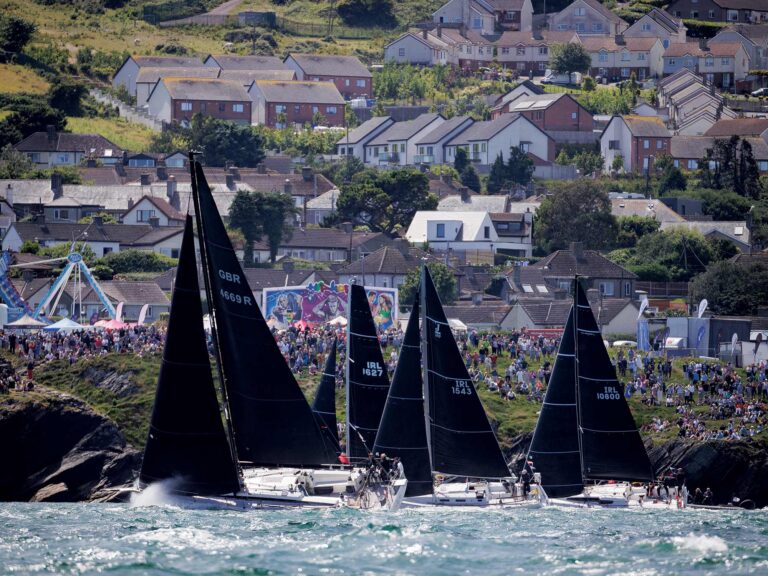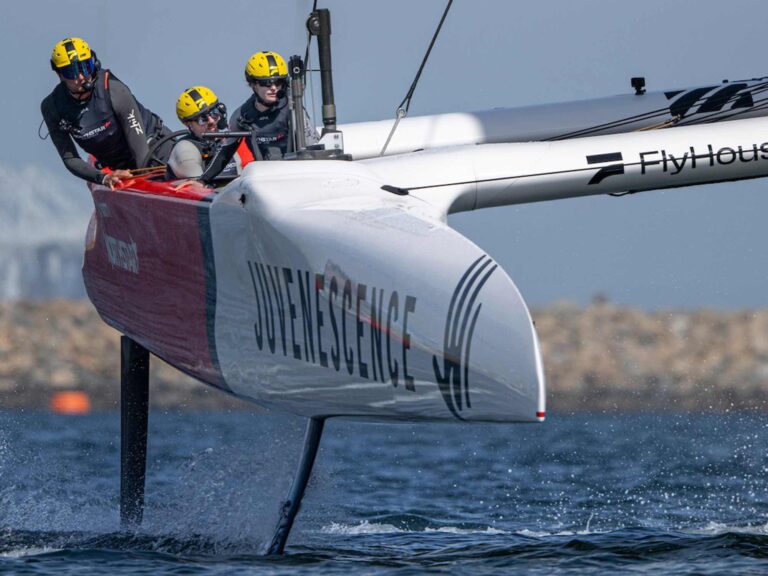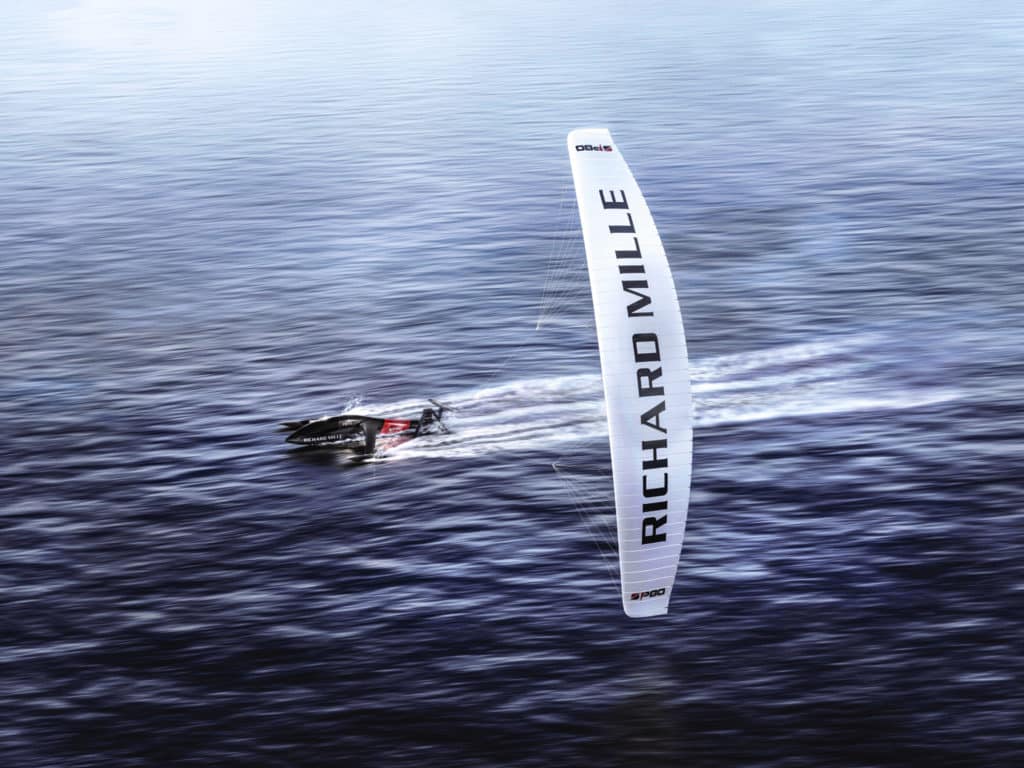
If Alex Caizergues succeeds at breaking the speed sailing world record in 2022, it will be his third time around using a kite, but otherwise completely different from his first two records. Those marks—50.57 knots in 2008 and 54.10 in 2010—were set when foiling boards were continually upping the 500-meter mark, sometimes more than once a year. Caizergues’ 2010 run added 3 knots to what the famed trimaran L’Hydroptere had shown us only a year before. But all those efforts ran into cavitation trouble at about 52 knots, that point when flow over the foils boils into vapor—the point at which control vanishes. For his early records, Caizergues used a hydrofoil to lift him above the water. Now, with his Syroco team based in Marseille, France, he intends to use a hydrofoil to hold him down.
We’ll come back to that.
Nine years after Paul Larsen’s record run at 65.45 knots in Sailrocket, the French Syroco team has rivals in Switzerland following what they believe is a more conservative path. The École Polytechnique Fédérale de Lausanne is a public research facility where the speed quest caught fire with student engineers and professors, including some who helped develop L’Hydroptere back in the day. SP80 is the team name, taken from the goal of achieving 80 knots, a goal shared with Syroco. They have a kissing-cousin relationship, competition aside.
SP80 envisions hitting 80 knots with a kite pulling a surface-skimming trimaran. A subsurface superventilating foil counters the lift of the kite, and a mechanical interface aligns the forces. Syroco’s purified vision aims to put a kite in the air connected by wires to a pod also in the air carrying two “pilots.” That pod will have a single, tiny-as-possible connection to a supercavitating subsurface foil holding it down. The concept strips the speed problem to its barest fundamentals, exponentially raising the complexity of execution.
Neither concept would pass as a boat in Blue Blazerville. Both owe their origins to Bernard Smith’s book, The 40-Knot Sailboat, published in 1963. Smith proposed a balance of opposing forces to avoid the ultimate instability that eventually and inevitably develops as power is added, and any ordinary craft will capsize. Sailrocket showed the way and validated the theory—using a canted wing, countered by a superventilating foil in the water. On November 24, 2012, with sponsorship money down to nickels and the weather window closing, Larsen clocked his 65.45-knot run at Walvis Bay, Namibia. These days, Larsen says he appreciates the respect shown by the principals of SP80 and Syroco when they call themselves “children of Sailrocket.” But when we keep this Australian-born Briton talking, we get to the part where he’s saying how the machine was packed away in a container in Namibia after just a few days of finally showing its potential, and there’s still gas in the tank and…
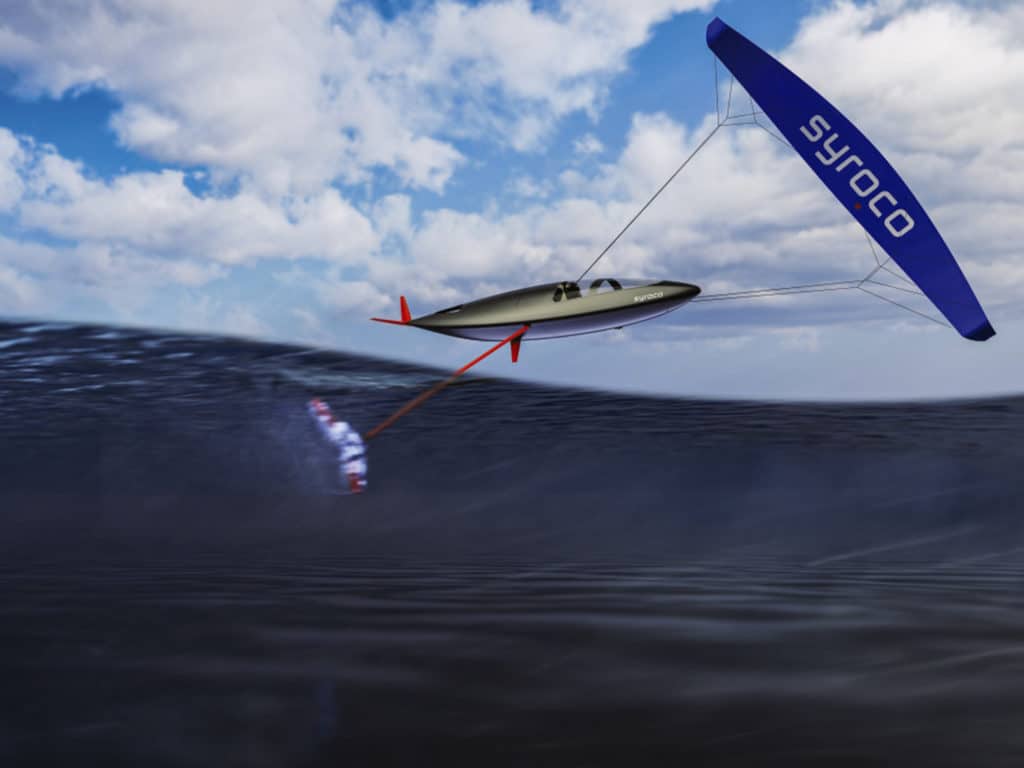
There’s nothing shaking right now, but don’t dismiss the current record holder, 49 years after the catamaran Crossbow set the first official 500-meter record at 26.30 knots. For bonus points, do you know how 500 meters became a standard record distance?
The simple answer: In 1972, when Crossbow was first contending at Weymouth, UK, that length fit the venue. If someone manages 80 knots in 2022, they will cover 500 meters in 12.15 seconds, a football field every 2.5 seconds.
Later, while we’re talking records, we’ll update the renovation of L’Hydroptere. First, let’s get up to speed on the essential terms. Supercavitation refers to a regime in which a small, highly loaded, wedge-shaped (triangular profile) foil builds a stable vapor pocket that bypasses the limits of cavitation. Superventilation refers to the principle employed by Sailrocket, with a foil that encouraged ambient air pressure to travel down the entire length and span of the foil.
The SP80 team puts it this way: “A triangular profile allows air from the atmosphere to dive into the extrados side caught by the depression, forming a stable air bubble that will prevent cavitation inception.”
Got it? Hey, they’re engineers.
Caizergues is aiming for more than a speed record with his Syroco concept. He knows from experience that when you succeed, you’re done and, “It’s an empty feeling.” This time, he’s ambitiously building a scientific and technical company around Syroco with the aim of reducing carbon emissions in the transportation and energy sectors. Co-founder Olivier Taillard, a Mini-Transat veteran, relates: “We founded the company in 2019 and built a team of 20. That includes three Ph.D.s in physics. To date, we have created 12 innovations, with three in the market. One is a software tool now in use to maximize efficiency in shipping routes.”
Other developments are aimed at keeping that critical hydrofoil just barely under the surface of the water, doing its supercavitating thing. Under the rules of the World Sailing Speed Record Council, only mechanical systems are allowed. It can’t be computerized or fly-by-wire. To a pointed question about systems, Caizergues responds with a laugh and a cagey hint: “Because of the wire, we’ll have air coming down from the surface, so it’s going to be about managing ventilation along with employing the principles of supercavitation. Not a lot of work has been done in this area, so we’re leading the way.” Prototype testing began in summer 2021, with plans to go for the record in 2022. Alongside more sober developments aimed directly at the marketplace, the team calls this one “the moonshot.”
When these people talk to each other, they toss around stuff like “turbulent viscosity formula in the Standard K-Epsilon model.” It’s not “let it out till it luffs, then pull it in.” SP80 co-founder Mayeul van den Broek observes: “Like Sailrocket, both of the current record efforts are based on the concept of aligning opposed forces, but then you prioritize either efficiency, power or stability. Syroco chose efficiency as a top priority. We chose stability, which is why we are producing such a different realization of the same concept.”
The SP80 principals witnessed L’Hydroptere’s stunning record run in 2009 and never quite got over it. Then, during a university competition to design the most efficient radio-controlled boat, they developed a hankering to try a superventilating foil on a kiteboard. When Benoit Gaudiot easily hit 41 knots, van den Broek says: “We saw that the rider was the weak link, and if we wanted to go faster, we would need a rigid link between the kite and the foil. Then, well, we might as well go for the record. We will use inflatable kites, even though a wing might be more efficient, because new-generation kites will serve at 80 knots. We can be versatile, launching kites from 20 to 50 square meters for different conditions.”
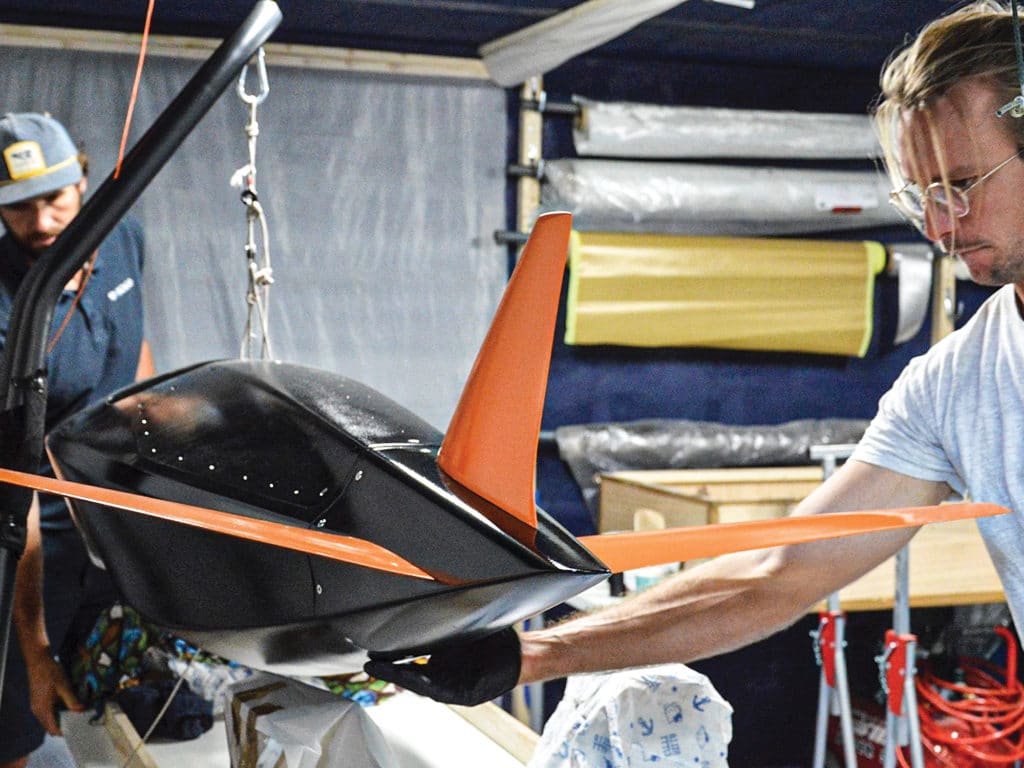
Their superventilating foils, Gaudiot says, “will have water flowing on one side and air on the other. Sailrocket used similar superventilating foils. That is less efficient than a supercavitating foil generating vapor, but it’s a lot more stable. A superventilating foil at low speed will develop more drag than a conventional foil. At high speed, it has no limits.”
SP80′s link between airfoil and hydrofoil depends upon a module that is, “mechanical but automatic,” according to van den Broek. “It will be close to the controls of a conventional kite.” Gaudiot adds, “Having one line carry all the power allows you to know exactly where that power will be coming from, and you can advance it into the window ahead for best performance, like any kite.”
In theory, there is no heeling and no capsizing because the power of the kite is countered by the force of the foil. As with Syroco, 2022 is the target record date.
Last year, we wrote in these pages about an ambitious plan to rehab the 60-foot foiling trimaran L’Hydroptere and put the old girl to work as a point-to-point record hunter. Gabriel Terrasse and Chris Welsh partnered to buy the legendary campaigner, once left derelict in Hawaii. They patched it up and had it sailed to San Francisco, where it was taken apart with an intent to rebuild it better than ever. Work was well along when Welsh—who would have carried on with or without sponsorship—died suddenly, and all bets were off, save for Terrasse’s persistence.
“We’re looking for sponsors,” Terrasse says, “and we have engineers studying how to add ground effect to L’Hydroptere 2.0 along with new foils, a longer and lighter main hull, a wingsail, global aerodynamic optimization and much more. It was hard to lose Chris. We shared the dream. But L’Hydroptere has great potential to serve science and catalyze innovation.”
L’Hydroptere’s 51.36-knot run in 2009 represented a last shot at setting speed records on water through pure muscle. Paul Larsen’s nine-year quest to solve the problem at a technical level culminated in that 65.45-knot run in 2012. Today the beast is still in a dark container in Namibia where Larsen packed it away. And yes, considering that Sailrocket had only a handful of runs in what turned out to be record-setting mode—fat foils, not thin foils, and according to the team’s VPP, 65 knots was a worst-case outcome; everything was structured to go 80 knots—it’s tempting to imagine putting Sailrocket 2 back on the track. What would change is the safety regime. It’s not hard to find videos online of early-version Sailrocket 1 going aerial.
“In any future scenario, I’d want a roll cage and oxygen,” Larsen says, “and maybe I’m at a point where I’d be happy to see someone else sitting there.”
“Tell Paul he’s getting soft,” was the joking comeback from Richard Jenkins when I mentioned that to him. Jenkins holds the land-speed sailing record at 126.2 knots, which took him “only” 10 years of trying as his various iterations developed. As far as we know, no one is challenging that record today. Jenkins’ story speaks to the difficulty of these endeavors in any medium. He says: “I’m often asked if I would try to break the record again. If I had unlimited funding and built a new vehicle, based on my cumulative knowledge, it might take me five years or more, and then we’d probably see an increment of 1 or 2 percent. It takes being in the right place at the right time, with certified observers, which is hard to put together. You then have to be technically perfect, at the right moment, with virtually no testing because wind might come suddenly. It takes a great deal of time and experience—and then you shoot from the hip. I have better things to do.”
Running his company, Saildrone, for example, with which Jenkins does his own part to care for the planet by fielding autonomous surface vehicles for ocean research. Having built a kite-powered trimaran 20 years ago, Jenkins worries the Swiss are “barking up the wrong tree.” But technologies evolve, and 2022 bids to be a fascinating time. Of Syroco’s moonshot, Taillard says: “Half of our brain power is spent making it safe. If a foil breaks, or if it comes out of the water—which isn’t going to happen—all safety systems have to work perfectly.”
Caizergues, who will be in Syroco’s control pod with a co-pilot, adds: “One of the goals is to produce a craft that will be safe for me to drive. And to crash. Helmets, oxygen, padding, quick-release mechanisms for sure, and we’re not committed to air bags, but maybe.”
Syroco and SP80 intend to run in the south of France, where the Mistral roars down to the Med. It worked for L’Hydroptere, but these new efforts place ever more extreme demands upon managing the interface between air and water, which at sea level is 784 times the density of air. The world will be watching, and perhaps I speak for many when I say, “Gentlemen: May the alignments of force be with you.”







